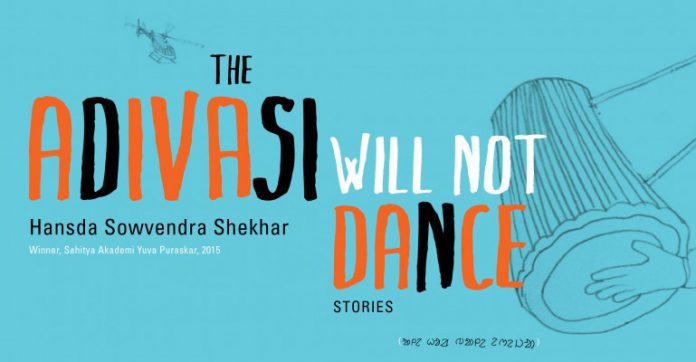Predicaments of Adivasis

The literary tradition of India obviously shows that whenever the feeble voice of the margins has grown loud and strong enough to be heard at the centre, the centre has no other option rather than listening to it. One such text that represents this aspect in the contemporary times is Hansda Sowvendra Shekhar’s The Adivasi Will Not Dance (2015). A collection of ten short stories dealing with Adivasis from Jharkhand, referred as Santhals, the book is an insightful representation of Santhali life and culture.
“Adivasi will not Dance” is an agonizing autobiography of Mangal Murmu, an old man who has trained dance troupes for years but refuses to sing and dance for a high profile function. Shekhar writes that a major inspiration for this short story came to the writer in 2013 when the President Pranab Mukherjee was visiting Jharkhand to inaugurate an ambitious thermal plant project which also implied that Adivasis will be displaced from their lands making them ‘homeless’. This had led to minor agitation amongst the Adivasis as it did not match with the egalitarian view (all are equal) of the State and responded well. In his narrative, he renders voice and words to the unspoken sentiments of the Santhals. Breaking the stereotype where the margins remain voiceless under the oppression of the centre, Mangal Murmu announces,
‘We Adivasis will not dance anymore’ – what is wrong with that? We are like toys – someone presses our ‘ON’ button, or turns a key in our backsides, and we Santhals start beating rhythms on our tamak and tumdak, or start blowing tunes on our tiriyo while someone snatches away our very dancing grounds. Tell me, am I wrong?
The last lines of the short story raise some deep-seated questions validating the growing industrialisation at the cost of the tribals, making the reader ponder over the booming economy and rethink of Victor Hugo’s quote that states, “…there is always more misery among the lower classes than there is humanity in the higher…”. He writes,
We will sing and dance before you but tell us, do we have a reason to sing and dance? Do we have a reason to be happy? You will now start building the power plant, but this plant will be the end of us all, the end of all the Adivasi. These men sitting beside you have told you that this power plant will change our fortunes, but these same men have forced us out of our homes and villages. We have nowhere to go, nowhere to grow our crops. How can this power plant be good for us? And how can we Adivasis dance and be happy? Unless we are given back our homes and land, we will not sing and dance. We Adivasis will not dance. The Adivasi will not –
At a glance, The Adivasi Will Not Dance may well appear to be a captivating tale of the confrontation between the powerful and the powerless, the rich and the poor. Despite dealing with events like human-trafficking, prostitution, women’s abuse, witch-hunting etc.
It also creates a kind of counter-narrative to the Euro-centric one by using the words from Santhali language. Words common in the Santhali vocabulary like jawan (soldier), pitha (sweet dish), lungi, gamcha, saya (types of wearing cloth), mathabhangi (broken head) are used within the sentences without giving any appendix. Quite unapologetic about refashioning the English language to suit the Santhali sentiments, he comments, “Glossaries are destructive. You come across a word, then you have to turn 200 pages to see its meaning, and then turn back to the story, It’s best to go with the flow”
The stories mainly depict the lives of Santhals from the Jharkhand region, constantly struggling to live their life with dignity in this mineral-rich land where corporate takeovers and development anthem is trending. The characters in the collection may not be real but the issues, the violence and the treatment that he depicts in his personal narrative is surely relevant to our times as the Ideologies of State has the potential to be major threat to the democratic and diverse fabric of the Indian society. In nutshell, these distinctive stories attempt towards sensitizing the society regarding various issues in society and especially the ones with the Santhals.
In such a condition, the denial of dance becomes an act of resistance and an attempt to challenge the state as they tried to suppress and marginalise a group of people. The refusal to dance is, thus, so infuriating to the President of India that he orders police, the RSA to beat up Mangal Murmu and his troupe. At the same time, his refusal to dance offers a counter-discourse against the power and authority, made by the upper-caste and upper-class. This denial is also a challenge to the State Power that had oppressed them and is still continuing to do so by snatching their lands away for industrial projects rendering them homeless, rootless, and even lifeless: “We are losing our Sarna-faith, our identities, and our roots. We are becoming people from nowhere”. He is shocked at the way the President who hails from the neighbouring district of Birbhum behaves to him and his troupe. The President is the representative of the State Apparatus here. He acts on behalf of the State and attribute the power against them, which is quite harrowing. This is a clear attempt to wipe out the voice of the subaltern. They are no longer in a position to raise a single moan of protest.

Thank you for making it short 💚
ReplyDelete